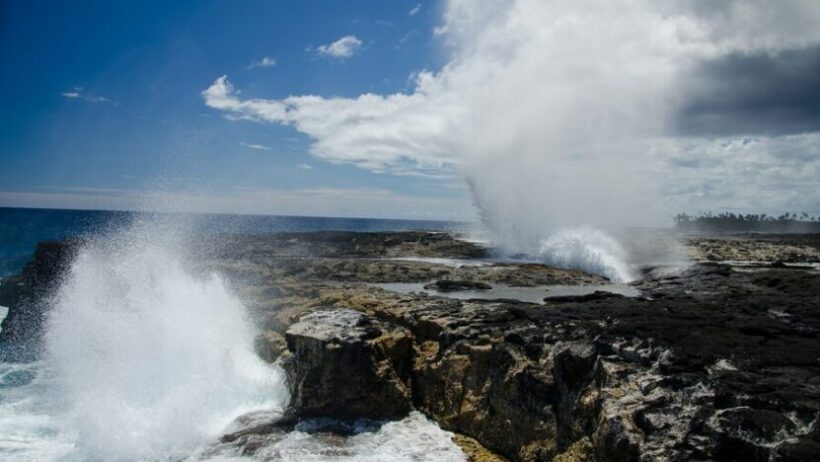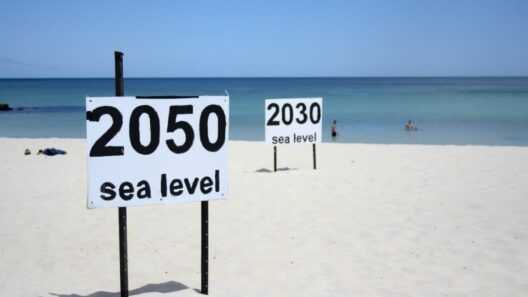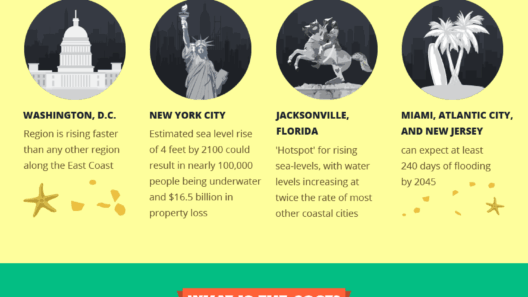Rising sea levels have become an increasingly pressing concern, reshaping coastlines and threatening ecosystems worldwide. Understanding the speed at which sea levels are rising is essential for climate resilience and policy-making. This article delves into the multifaceted elements surrounding sea level increase, providing quantitative data, underlying causes, and potential implications for future generations.
The current scientific consensus indicates that global sea levels are rising at an alarming rate, primarily driven by climate change. Historically, sea levels have fluctuated due to various geological factors, but modern changes are largely anthropogenic. The Intergovernmental Panel on Climate Change (IPCC) reported that the global sea level has risen approximately 20 centimeters since the late 19th century. However, the acceleration of this trend is what warrants concern.
The average rate of sea level rise from 1901 to 1990 was about 1.2 millimeters per year. This rate, while gradual, masked a more aggressive increase observed in the last few decades. From 1993 to present, satellite altimetry has shown that the rate of rise has nearly doubled to 3.3 millimeters per year. Some studies predict that, by the end of the 21st century, sea levels could rise by as much as 1 meter, depending on greenhouse gas emission scenarios.
Unpacking the Causes of Acceleration
To understand the rapid increase in sea levels, we must delve into the dual phenomena of thermal expansion and glacial melt. Atmospheric warming directly impacts ocean temperatures, leading to thermal expansion. As the temperature of the water increases, it expands, thus occupying a greater volume – a process that can substantially elevate sea levels.
In tandem, the melting of glaciers and polar ice caps significantly contributes to rising waters. Antarctica and Greenland are shedding vast amounts of ice due to rising temperatures and changing precipitation patterns. The West Antarctic Ice Sheet, in particular, has become a focal point for scientists studying the sea level rise, with alarming loss rates of ice mass. As these land-based ice reservoirs continue to diminish, they contribute increasingly to the global sea level rise.
It is important to recognize the regional disparities in sea level rise, driven by dynamic local factors. Changes in ocean currents, land subsidence, and tectonic activities can influence how coastal regions experience rising seas. For example, some areas may witness greater elevation increases, while others may fluctuate due to geological shifts or environmental factors. This variability complicates the anticipated effects of rising sea levels, necessitating localized assessments and responses.
Navigating the Implications of Rising Seas
The implications of sea level rise extend beyond environmental statistics; they impact human life and economic stability. Coastal communities are particularly vulnerable, facing an array of challenges such as increased flooding, loss of habitat, and contamination of freshwater supplies. According to projections, significant urban regions, including Miami, New Orleans, and parts of New York City, could experience regular flooding by the mid-21st century if current trajectories persist.
Moreover, socioeconomic disparities amplify the risks associated with rising sea levels. Low-income communities often reside in high-risk areas, lacking infrastructural resources to mitigate the impacts. This situation leads to a cycle of inequity, with these populations facing disproportionate challenges in adapting to changing environments. Understanding these dimensions is pivotal to crafting comprehensive policy responses that are equitable and effective.
Environmental and Ecological Ramifications
The ecological ramifications of sea level rise are profound, altering the delicate balance of coastal ecosystems. Tidal wetlands, mangroves, and coral reefs are critical in maintaining biodiversity, but rising seas threaten their very existence. Saltwater intrusion can disrupt estuaries, negatively impacting fish and wildlife populations reliant on these habitats for spawning and nourishment.
Coral reefs, which provide a natural barrier against storm surges and erosion, face the dual threat of warming oceans and increased acidic levels resulting from carbon absorption. A change in seawater composition can lead to coral bleaching, compromising entire ecosystems that depend on vibrant coral structures. The loss of biodiversity within these ecosystems doesn’t merely endanger local wildlife – it also affects human communities relying on these ecological services for their livelihoods.
Innovative Solutions and Adaptation Strategies
Addressing the challenges posed by rising sea levels requires innovative thinking and cooperative action at multiple scales. Adaptation and resilience strategies must focus on enhancing coastal defenses while restoring natural systems, such as wetlands and mangroves, which serve as buffers. Managed retreat, alternative land use, and sustainable urban planning will be critical in protecting vulnerable populations.
Integrating scientific research with community-led initiatives can foster resilience. Local governments, in collaboration with climate scientists, can develop tailored approaches that address the specific needs and characteristics of affected regions. By investing in infrastructure, promoting green spaces, and raising public awareness, coastal communities can position themselves to withstand the adverse effects of rising seas.
Conclusion: A Collective Responsibility
As the world grapples with the realities of rising sea levels, it becomes clear that understanding the complexities of this ecological phenomenon is paramount. The urgency of addressing climate change cannot be overstated, as the very fabric of coastal societies hangs in the balance. It is a shared responsibility to advocate for solutions fostering ecological integrity and community resilience. Through informed action and collective commitment, society can navigate the challenges posed by rising seas and ensure a sustainable future for generations to come.








